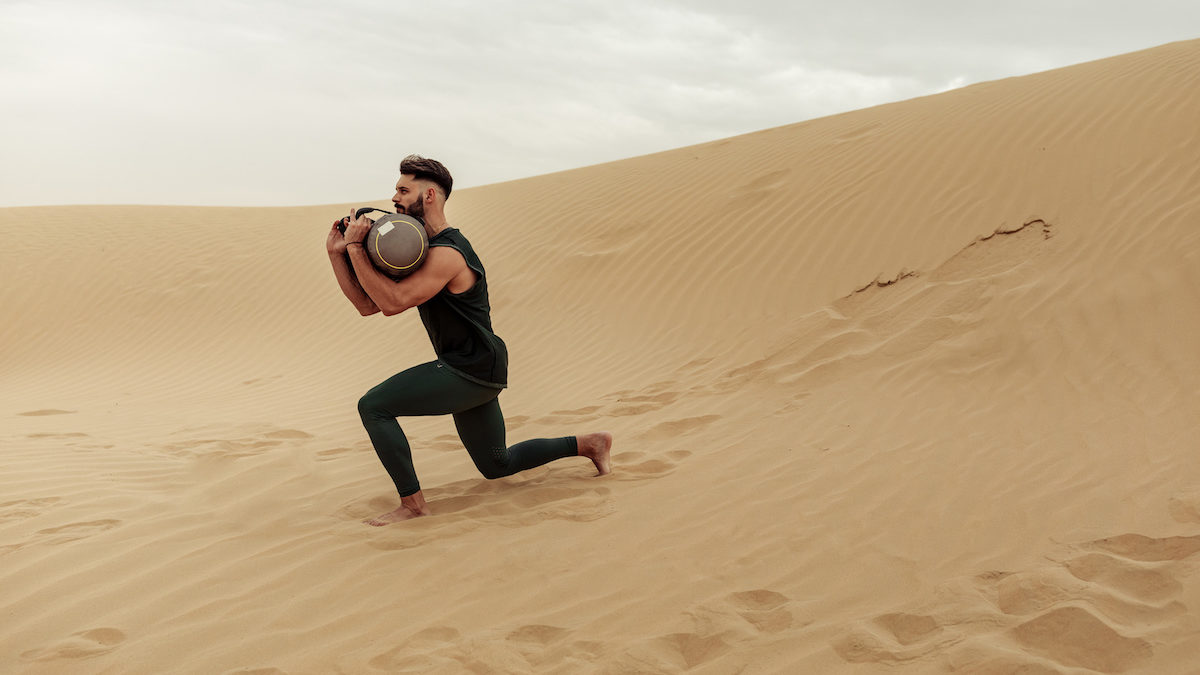How a Year of Home Workouts Has Unleashed the Power of Going Barefoot

The billion-dollar sneaker industry would have you believe that shoes are as imperative to gym life as the weights you’re lifting. And, sure there are numerous reasons why shoes can be beneficial in all forms of training, from running shoes that return energy with every stride to chunky power-lifting shoes that protect your ankles and keep you firmly grounded through every strenuous squat. But if our recent home workouts have proved anything it’s that freeing our feet can have benefits too.
“I started training barefoot around 2018 when I did a workout at home for the first time,” says movement coach, Rianna Kate. “I didn’t see the sense in wearing shoes in my own house. It’s only much later on that I’ve realised the incredible benefit of training barefoot and the advantage it gives me in terms of joint stability and mobility. But it’s definitely not the reason I started.”
Now a barefoot workout expert, Rianna takes us through everything you need to know about training sans footwear, from the best exercises to do barefoot to keeping your feet clean in the gym.
The Benefits Of Barefoot Workouts
Being barefoot is essentially the most natural form of being. We invented shoes to cope with new environments just like we invented exercise to cope with a lack of physical activity.
You might then find that squatting a heavy load at the gym is harder than with shoes at first. But as kids, we typically learn to stand and walk long before shoes, and they do about 100 squats a day just trying to make it happen (with perfect form I might add).
Back To Nature
It’s a natural movement for nearly every child, and it’s only later in life that we — mainly in the West — find squatting to be more difficult barefoot because chairs have increased the tension in our muscles through years of habitually sitting in a similar position.
When you move barefoot, you increase ankle stability and joint mobility. Big toes play a key role in balance, but unless you’re barefoot or in a pair of Vivos, you don’t have the space to press your big toe into the ground because of the narrowing of shoes towards the toes.

Correcting Improper Technique
Shoes may have amazing cushioning properties, just like the ball of your foot, but how many people have an improper running technique and heel strike the ground on every stride?
This comes as a result of wearing shoes as it’s impossible to run barefoot and heel strike without a serious amount of pain. If you look at professional runners, they run on the balls of their feet or strike the ground mid-foot, because that’s where our most natural cushioning is. Even if you’re wearing running shoes, think about your running stride as if you weren’t.
Functional Fitness
I spend a lot of time hiking, and while I don’t hike over rocky terrain barefoot, I am now much less likely to hurt myself if I trip and roll my ankle due to increased mobility and stability in that area.
Hiking doesn’t lend itself well to single-plane fixed movements, nor does a game of football or netball. When players lunge for a ball their knee is not “directly over their ankle with their head up and shoulders back and down with arms perfectly by their sides”.
So-called functional fitness means training in a way that benefits your life outside of the gym. While I am not suggesting that we all start playing ball sports sans shoes, training without them can improve your body’s reaction to load, so that when you do venture onto the pitch, court, or mountain, you are better prepared to avoid injury.

The Best Exercises For Working Out Barefoot
For barefoot beginners I’d recommend bodyweight mobility exercises and yoga. This type of movement stresses your muscles and ligaments at various angles, so your body adapts to load from unusual positions, putting you in a primed state over time to add load if you want to.
It will also start to increase proprioception, which is your own awareness of your body in the space it’s in, i.e. stepping back into a lunge without having to look at your foot.
For more advanced movers and shakers, kettlebell work is obviously great because you can get very creative with the different movement patterns.
Similarly, sequences often found as the base of arts like Brazilian Jiu-Jitsu are incredibly challenging and fun to incorporate into training sessions because they require a lot of focus. You spend time developing the skill, honing proprioception, and a great deal of joint mobility is required (which you don’t need to get started, by the way).
Generally, unless you’re very comfortable without shoes and have a solid training history I would stay away from plyometrics, also known as jump training, as the potential for injury is quite high. I will occasionally skip barefoot to test my technique but would for obvious reasons not be running around London without shoes.

Are There Any Dangers?
For anyone that has weak ankles or ligament issues that usually require insoles, training barefoot can be very uncomfortable and can promote further injury if form is not addressed.
I would always advise a slow transition to barefoot training if it’s something you aren’t used to and it’s important to know your own limits. However, if you are unsure, then please consult a professional who can outline tailored recommendations.
Hygiene When In The Gym
Personally, when I can get away with it and not get thrown out, I train in socks in a gym (if I must be in a gym). Otherwise I will always travel to and from a gym environment in my Vivo barefoot shoes so that if the gym have a real issue with ‘no shoes’ then at least I have something comfortable and as close to barefoot as a shod foot comes.


















